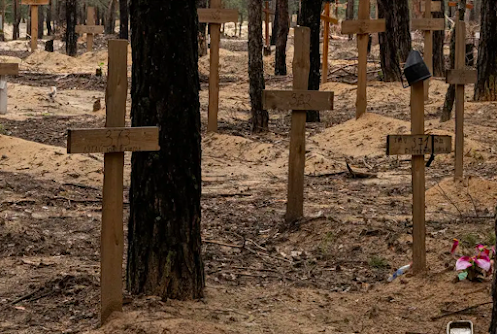It isn't often that reality eclipses Conceptual Art as it's usually the other way around. But here it does because unlike Art which is made up from imagination, reality is fact-based. And the facts here are that Putin's Russian dictatorship has tortured, executed, and buried its victims in a mass grave in this sparse-looking pine forest in the Eastern region of Ukraine only recently liberated after eight months of occupation.
(My apologies to the photographer whose credit was lost in translation)
In this photo I was struck by a poignant desolation and how these make-shift crosses mingle haphazardly inside such an empty looking forest. We are so accustomed to seeing graves marked by white crosses in neat rows or marked with simple headstones in a field surrounded by beds of grass. But in this place, grass will surely never grow back.
Almost in a vision I saw in this forest scene a kind of elegiac portrait in which small crosses are protected by trees, their elders perhaps, barely still alive themselves and undernourished; a ghetto family of trees, burned and ravaged-looking but still hanging on to life, still spared the fate of the cut up crosses identified only by obscure numbers drawn with cheap black markers.
I try to imagine how Conceptual Art might treat this scene, this aftermath of torture, a war's consequence's, as if anything could still be added or contextualised upon it. It's a heavy theme, a giant subject that over the centuries many, many artists have attempted to convey.
But this forest scene is not a work of art, it is the result of a brutal war of aggression, fact-based, where even an adjective like 'brutal' feels like a lazy cliché. How to describe what happened here or at any murder scene anywhere? This is what motivates artists, but can it really be done? Picasso's Guernica stands out and it was an instant hit in 1937, and it still is today.
The Holocaust atrocities are presented to the world in a very frank and straight-forward manner, the bare bones of documentation, as it were. How else to explain or contextualise the terror and brutality of genocide with details of what had happened?
The Nazi genocide has been presented clearly, simply and soberly, allowing the photos and objects themselves to speak the unspeakable. In fact, come to think of it, it was a kind of preemptive precursor to how Conceptual Art pieces would soon be presented themselves. After the war the German artist Joseph Beuys practically invented Conceptual Art in the simplest terms for he was clever and original, an emerdeur first class; inimitable and copied like a xerox machine.
I have never been to the memorial at Auschwitz-Birkenau but I have always wanted to go, maybe (hopefully) on my next trip in Europe I will remember to finally go.
This forest too, will also be a place of remembrance in Ukraine, not a museum to attend, but a place to go in somber thought and prayer like at Auschwitz-Birkenau and other places of other genocides.



























